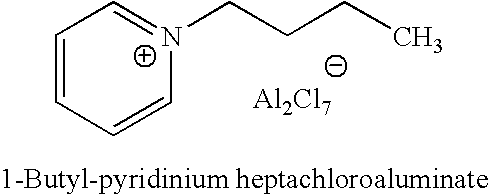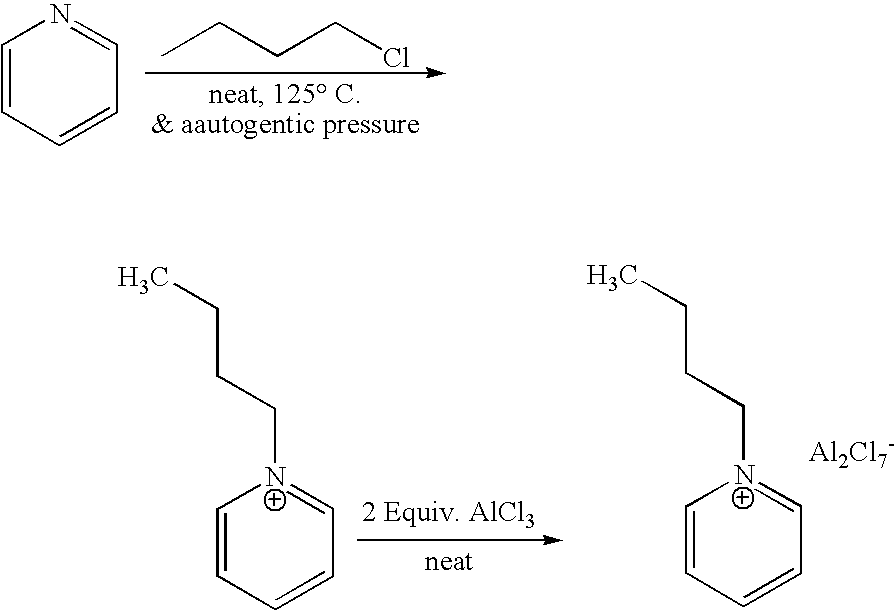Ionic liquid catalyst having enhanced activity
a technology of ionic liquid and catalyst, which is applied in the field of ionic liquid catalysts with enhanced activity, can solve the problems of increasing catalyst handling equipment and reducing these costs, and achieve the effect of increasing the activity of ionic liquid catalysts and increasing the activity of catalysts
- Summary
- Abstract
- Description
- Claims
- Application Information
AI Technical Summary
Benefits of technology
Problems solved by technology
Method used
Image
Examples
example 1
Preparation of Fresh 1-Butylpyridinium Chloroaluminate Ionic Liquid Catalyst A (Fresh IL A)
[0027] 1-butyl-pyridinium chloroaluminate is a room temperature ionic liquid prepared by mixing neat 1-butyl-pyridinium chloride (a solid) with neat solid aluminum trichloride in an inert atmosphere. The syntheses of butylpyridinium chloride and the corresponding 1-butyl-pyridinium chloroaluminate are described below. In a 2-L Teflon-lined autoclave, 400 gm (5.05 mol.) anhydrous pyridine (99.9% pure purchased from Aldrich) were mixed with 650 gm (7 mol.) 1-chlorobutane (99.5% pure purchased from Aldrich). The neat mixture was sealed and let to stir at 125° C. under autogenic pressure over night. After cooling off the autoclave and venting it, the reaction mix was diluted and dissolved in chloroform and transferred to a three liter round bottom flask. Concentration of the reaction mixture at reduced pressure on a rotary evaporator (in a hot water bath) to remove excess chloride, un-reacted pyri...
example 2
Activation of IL A Using Al Metal and HCl
[0029] The activation was done in a batch reactor according to the following procedure. In a 300 cc autoclave, 75 gm of freshly made 1-butyl-pyridinium chloroaluminate ionic liquid, prepared as described in example 1, were mixed with 8 gm of aluminum powder in a an oxygen and water-free glove box under nitrogen. The autoclave was sealed and 5.5 gm of anhydrous HCl gas from a Lecture Bottle was added via an inlet. The mixture was then vigorously mixed with an overhead stirrer at ˜>1200 rpm at room temperature and the autogenic pressure (230 psig at the start of the reaction) for only 15 minutes. The reaction temperature rose to ˜30° C. and the pressure dropped to 203 psig. The autoclave (the reaction vessel) was vented off and let to cool back to room temperature. Then, the treated ionic liquid was filtered from the aluminum powder and the produced aluminum chloride. The filtered ionic liquid was somewhat milky in appearance due to the presenc...
example 3
Determination of Activity of Treated IL A Using Batch Alkylation of isoPentane with Ethylene
[0030] The alkylation of isopentane with ethylene was done according with the following procedure. A 300 cc autoclave was charged with 42 gm of ionic liquid catalyst, 100 gm of anhydrous isopentane, 12 gm of ethylene, and 0.3 gm of anhydrous HCl. The reaction was then stirred ˜1200 rpm and heated to 50° C. at autogenic pressures. The starting pressure was usually 215-320 psi. The reaction was usually complete when the pressure dropped down to single digits. At the end of the reaction, the reactor was vented out and a gas sample was checked by GC for ethylene concentration. The liquid reaction mixture was allowed to settle into 2 phases. The organic phase was decanted and analyzed for product distribution by GC analysis. The following Table 1 draws a comparison between the freshly made and the treated catalysts.
TABLE 1Fresh CatalystActivated CatalystReaction Time7 min.3 min.Starting Pressure...
PUM
| Property | Measurement | Unit |
|---|---|---|
| Temperature | aaaaa | aaaaa |
| Time | aaaaa | aaaaa |
| Time | aaaaa | aaaaa |
Abstract
Description
Claims
Application Information
 Login to View More
Login to View More - R&D
- Intellectual Property
- Life Sciences
- Materials
- Tech Scout
- Unparalleled Data Quality
- Higher Quality Content
- 60% Fewer Hallucinations
Browse by: Latest US Patents, China's latest patents, Technical Efficacy Thesaurus, Application Domain, Technology Topic, Popular Technical Reports.
© 2025 PatSnap. All rights reserved.Legal|Privacy policy|Modern Slavery Act Transparency Statement|Sitemap|About US| Contact US: help@patsnap.com


